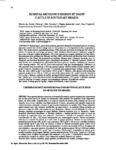Use este identificador para citar ou linkar para este item:
http://www.alice.cnptia.embrapa.br/alice/handle/doc/580379Registro completo de metadados
| Campo DC | Valor | Idioma |
|---|---|---|
| dc.contributor.author | PEDREIRA, M. S. | pt_BR |
| dc.contributor.author | PRIMAVESI, O. | pt_BR |
| dc.contributor.author | LIMA, M. A. de | pt_BR |
| dc.contributor.author | FRIGHETTO, R. T. S. | pt_BR |
| dc.contributor.author | OLIVEIRA, S. G. de | pt_BR |
| dc.contributor.author | BERCHIELLI, T. T. | pt_BR |
| dc.date.accessioned | 2016-06-03T12:42:07Z | - |
| dc.date.available | 2016-06-03T12:42:07Z | - |
| dc.date.created | 2010-01-14 | pt_BR |
| dc.date.issued | 2009 | pt_BR |
| dc.identifier.citation | Scientia Agricola, Piracicaba, v. 66, n. 6, p. 742-750, 2009. | pt_BR |
| dc.identifier.uri | http://www.alice.cnptia.embrapa.br/alice/handle/doc/580379 | pt_BR |
| dc.description | ABSTRACT: Ruminal gases, particularly methane, generated during the fermentative process in rumen, represent a partial loss of feed energy and are also pointed to as an important factors in greenhouse effect. This study aimed at quantifying methane (CH 4) emission rates from lactating and dry cows and heifers, 24 month-old in average, on pasture under Southeast Brazil tropical conditions, using the tracer gas technique, sulphur hexafluoride (SF 6), four animals per category, distributed in four blocks. Measurements were performed in February and June, 2002, with Holstein and Brazilian Dairy Crossbred (Holstein ¾ x Gir (Zebu) ¼), maintained on fertilized Tanzania-grass (Panicum maximum Jacq. cv. Tanzania) and fertilized Brachiaria-grass (Brachiaria decumbens cv. Basilisk) pastures. Heifers of both breeds were maintained on unfertilized Brachiaria-grass to simulate conditions of extensive cattle farming systems. CH 4 and SF 6 levels were measured with gas chromatography. Differences in CH4 emissions were measured (p < 0.05) for genetical groups. Holstein produced more methane (299.3g day?1) than the Crossbred (264.2 g day?1). Lactating cows produced more methane (353.8 g day?1) than dry cows (268.8 g day?1) and heifers (222.6 g day?1). Holstein, with greater milk production potential, produced less CH4 (p < 0.05) per unit of dry matter intake (19.1 g kg?1) than the Crossbred (22.0 g kg?1). Methane emission by heifers grazing fertilized pasture (intensive system) was 222.6 g day?1, greater (p < 0.05) than that of heifers on unfertilized pasture (179.2 g day?1). Methane emission varied as function of animal category and management intensity of production system. | pt_BR |
| dc.language.iso | eng | eng |
| dc.rights | openAccess | eng |
| dc.title | Ruminal methane emission by dairy cattle in southeast Brazil. | pt_BR |
| dc.type | Artigo de periódico | pt_BR |
| dc.date.updated | 2016-06-03T12:42:07Z | pt_BR |
| dc.subject.thesagro | Metano | pt_BR |
| dc.subject.thesagro | Pecuária | pt_BR |
| riaa.ainfo.id | 580379 | pt_BR |
| riaa.ainfo.lastupdate | 2016-06-02 | pt_BR |
| dc.contributor.institution | MÁRIO DOS SANTOS PEDREIRA, UESB; ODO PRIMAVESI, CPPSE; MAGDA APARECIDA DE LIMA, CNPMA; ROSA TOYOKO SHIRAISHI FRIGHETTO, CNPMA; SIMONE GISELE DE OLIVEIRA, UFPR; TELMA TERESINHA BERCHIELLI, FCAV/UNESP. | pt_BR |
| Aparece nas coleções: | Artigo em periódico indexado (CNPMA)  | |
Arquivos associados a este item:
| Arquivo | Descrição | Tamanho | Formato | |
|---|---|---|---|---|
| 2009AP11.pdf | 206,16 kB | Adobe PDF |  Visualizar/Abrir |









